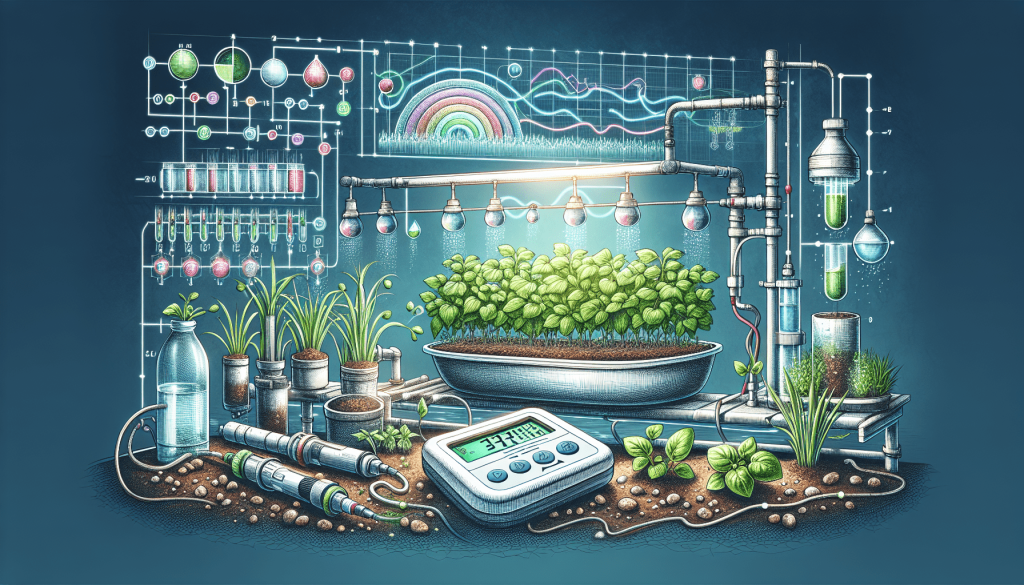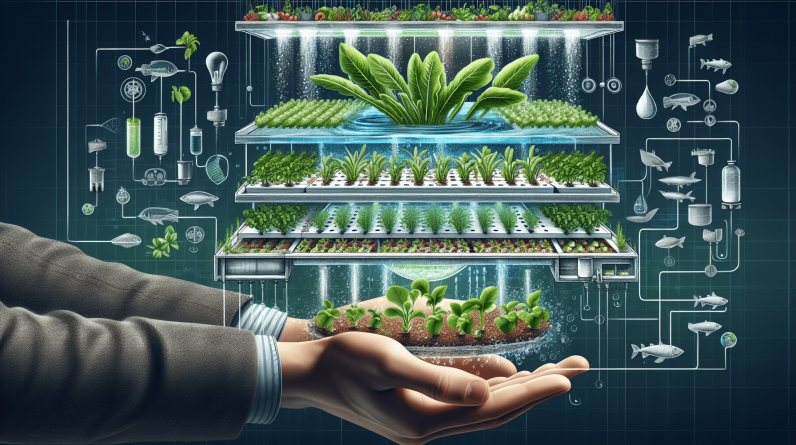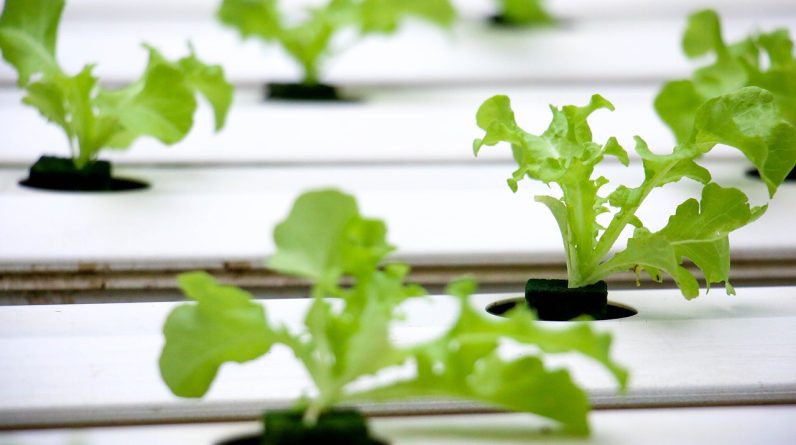
If you’re interested in hydroponic gardening, one crucial aspect to consider is how to maintain the pH levels of your nutrient solution. Ensuring the correct pH balance is essential for the optimal growth and health of your plants. In this article, we will explore some practical tips and techniques to help you maintain the ideal pH levels in your hydroponic garden, so you can enjoy thriving plants and a bountiful harvest.
Importance of Maintaining pH Levels
Maintaining proper pH levels is crucial in hydroponic gardening to ensure optimal plant growth and development. pH levels directly affect nutrient availability and absorption, as well as the overall health of the plants. When pH levels are within the appropriate range, plants can effectively take up nutrients and minerals, leading to stronger root systems, enhanced photosynthesis, and improved overall vigor.
Optimal pH Range
The optimal pH range for hydroponic systems generally falls between 5.5 and 6.5. This slightly acidic to neutral range allows for the optimal solubility of nutrients in the water, ensuring easy absorption by the plants’ roots. Different plants may have specific pH preferences, so it is important to research and adjust the pH according to their needs.
Effects of pH Imbalance
pH imbalances can have detrimental effects on plants. When the pH is too high (alkaline), essential nutrients such as iron, manganese, and zinc become less available to the plants, leading to nutrient deficiencies. On the other hand, if the pH is too low (acidic), elements such as phosphorus, calcium, and magnesium can become less soluble, hindering their absorption by the roots.
Benefits of Maintaining pH Levels
Maintaining proper pH levels in hydroponic systems offers numerous benefits. Firstly, it ensures optimal nutrient uptake by the plants, leading to healthy growth and robust yields. Additionally, maintaining pH stability allows for the prevention of nutrient lockout, which occurs when certain nutrients become less available due to pH imbalances. By regularly monitoring and adjusting pH levels, hydroponic gardeners can create an ideal environment for their plants, maximizing their potential and overall health.
Measuring pH Levels
Accurate measurement of pH levels is vital to maintaining a healthy hydroponic system. There are several methods available for testing pH levels, each with its own advantages and suitability for different setups.
pH Testing Kits
pH testing kits are affordable and widely available tools that allow gardeners to measure pH levels with relative ease. These kits usually consist of pH indicator solution or test strips, along with a color chart to determine pH levels. They provide a quick and convenient way to measure pH but may not offer the same level of precision as more advanced methods.
Digital pH Meters
Digital pH meters provide precise and reliable pH measurements, making them a popular choice among hydroponic gardeners. These handheld devices use electrodes to measure the electrical potential difference between a sample and a reference electrode, providing an accurate pH reading. Digital pH meters are more expensive than testing kits but offer greater accuracy and repeatability.
Proper Testing Techniques
Regardless of the method chosen, it is important to follow proper testing techniques to ensure accurate measurements. Clean the testing apparatus thoroughly and collect a representative sample of the nutrient solution. Avoid taking readings immediately after adjusting the pH, as it may take some time for the solution to stabilize. Repeat the measurement multiple times to verify the results and adjust accordingly.
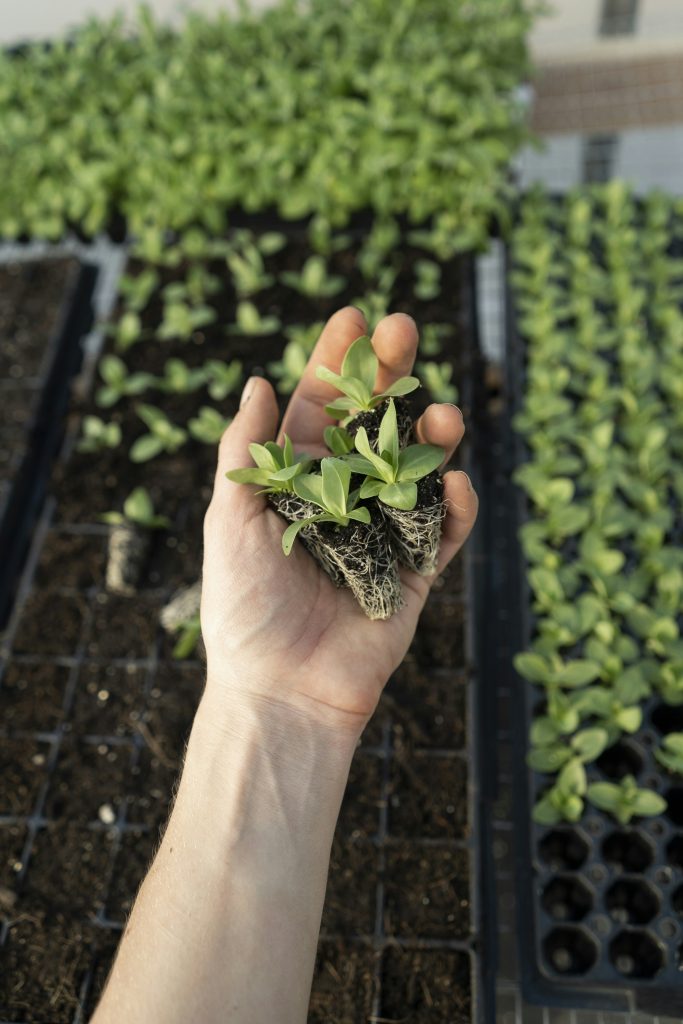
Adjusting pH Levels
Maintaining proper pH levels often requires adjustments to bring the nutrient solution within the desired range. There are various methods available to raise or lower pH levels, depending on the specific needs of the hydroponic system.
Use of pH Up and pH Down Solutions
pH up and pH down solutions are commonly used to adjust pH levels in hydroponic systems. pH up solutions, usually based on potassium hydroxide, are used to raise pH, while pH down solutions, typically containing phosphoric or citric acid, are used to lower pH. These solutions can be added to the nutrient solution in small increments until the desired pH level is achieved.
Natural pH Adjusters
Some gardeners prefer to use natural substances to adjust pH levels, such as organic acids from fruits or vegetables. Citric acid from lemons or limes, for example, can be used to lower pH, while wood ash or limestone can be used to raise pH. It is important to research and understand the effects of these natural pH adjusters before using them to ensure they are suitable for the specific plants and hydroponic system.
Correcting pH Imbalances
When pH levels deviate from the desired range, it is important to address the issue promptly to prevent any adverse effects on plant health. By regularly monitoring pH levels and adjusting as necessary, hydroponic gardeners can ensure a stable pH environment, promoting optimal nutrient uptake and overall plant growth.
Monitoring pH Levels
Regular monitoring of pH levels is essential to maintain a healthy hydroponic system. By implementing a consistent pH testing schedule and keeping detailed records, gardeners can effectively monitor and manage pH levels in their setups.
Regular pH Testing Schedule
Establishing a regular pH testing schedule is crucial to catch any potential imbalances early on. Depending on the specific needs of the plants and system, pH levels should be tested at least once a day or every few days. The frequency of testing may vary throughout different stages of plant growth, as certain plants may have more specific pH requirements during different phases.
Keeping Records
Keeping accurate and detailed records of pH measurements is important for identifying patterns or trends over time. By maintaining a record of pH levels and any related observations, gardeners can make informed adjustments to their hydroponic system to maintain optimal pH stability. This information can also be useful to track the response of plants to various pH levels and fine-tune the growing conditions.
Indicators of pH Imbalance
In addition to regular pH testing, there are several indicators that may suggest a pH imbalance in a hydroponic system. Signs of nutrient deficiencies or toxicities, reduced growth rates, and yellowing or browning of leaves can all be indicative of pH issues. By paying close attention to these indicators and regularly monitoring pH levels, hydroponic gardeners can maintain a healthy pH environment for their plants.

Maintaining pH Stability
Maintaining pH stability is crucial for the long-term success of a hydroponic system. By implementing certain practices and considerations, gardeners can ensure a consistent and optimal pH environment for their plants.
Consistency in Nutrient Solution
Maintaining consistency in the nutrient solution is key to pH stability. By following a consistent nutrient recipe and accurately measuring and dosing nutrients, gardeners can minimize fluctuations in pH levels. It is important to refresh and replace the nutrient solution regularly to prevent the accumulation of excess minerals or contaminants.
Water Quality Considerations
Water quality plays a significant role in maintaining pH stability. Water sources with high levels of dissolved solids or pH-altering minerals can potentially impact the pH levels in a hydroponic system. Using purified water or implementing appropriate water treatment methods can help maintain a stable and consistent pH environment.
Effects of Temperature on pH
Temperature can also affect pH stability in a hydroponic system. Warmer temperatures generally increase the metabolic activity of plants, potentially impacting nutrient absorption and pH balance. Regularly monitoring and controlling the temperature within the recommended range can help maintain a stable pH environment.
Preventing pH Fluctuations
Preventing pH fluctuations is essential for the overall health and productivity of hydroponic plants. By implementing certain practices and strategies, gardeners can minimize the occurrence of pH imbalances.
Proper Nutrient Solution Mixing
Properly mixing the nutrient solution is crucial to prevent pH fluctuations. Ensuring thorough and consistent mixing of nutrients before introducing them to the system helps distribute them evenly and prevents localized imbalances. It is important to follow the manufacturer’s instructions and guidelines for nutrient mixing ratios to maintain a balanced pH environment.
Avoiding Contaminants
Contaminants can contribute to pH fluctuations and nutrient imbalances in a hydroponic system. Avoiding the introduction of contaminants, such as dust, dirt, or organic matter, into the nutrient solution helps maintain pH stability. Regularly cleaning and sterilizing equipment, such as reservoirs, pumps, and tubing, also helps prevent the buildup of harmful substances that can alter pH levels.
Managing Plant Health
Keeping plants healthy and free from pests and diseases is essential to prevent pH fluctuations. Stressed or damaged plants may exhibit reduced nutrient uptake or altered metabolic processes, leading to pH imbalances. Implementing proper plant care practices, such as regular pruning, pest control, and disease prevention, helps maintain overall plant health and minimizes the risk of pH fluctuations.
Addressing Common pH Issues
Addressing common pH issues promptly is crucial to prevent further damage to plants. There are specific strategies for addressing pH issues based on whether the pH is too high (alkaline) or too low (acidic).
pH Too High (Alkaline)
If the pH is too high, indicating an alkaline environment, several steps can be taken to lower it. Adding pH down solutions or natural pH adjusters, such as organic acids, can help decrease the pH levels. Additionally, adjusting the nutrient solution’s composition and balancing the nutrient ratios can help restore pH balance.
pH Too Low (Acidic)
In cases of low pH levels, indicating an acidic environment, adding pH up solutions or natural pH adjusters, such as wood ash or limestone, can help raise the pH. Adjusting the nutrient solution’s composition and ensuring a balanced nutrient ratio can also aid in restoring pH balance.
Resolving pH Drift
pH drift refers to the gradual shift in pH levels over time, often caused by the accumulation of minerals or other factors. Regular monitoring and adjustment of pH levels, as well as refreshing and replacing the nutrient solution, can help resolve pH drift. Additionally, maintaining consistent water quality and nutrient dosing practices can prevent pH drift from occurring.
pH Management Techniques
Different hydroponic systems require specific pH management techniques to ensure optimal plant growth and health. Some commonly used techniques include:
Top-Feed Hydroponic Systems
In top-feed hydroponic systems, where nutrient solution is periodically pumped to the growing medium from the top, maintaining consistent pH levels is important. Regular pH monitoring and adjustment of the nutrient solution, as well as ensuring even distribution throughout the growing medium, helps maintain pH stability.
Nutrient Film Technique (NFT)
In NFT systems, a thin film of nutrient solution continuously flows over the plant roots. It is important to maintain a constant and balanced pH level in the nutrient solution to optimize nutrient absorption in this system. Regular monitoring and adjustment of pH levels, along with proper balancing of nutrient ratios, are key in NFT pH management.
Deep Water Culture (DWC)
DWC systems involve suspending the plant roots in a nutrient solution. Maintaining proper pH levels in these systems is crucial to prevent nutrient deficiencies or toxicities. Regular monitoring and adjustment of pH, as well as ensuring oxygen levels in the nutrient solution, are important for successful pH management in DWC setups.
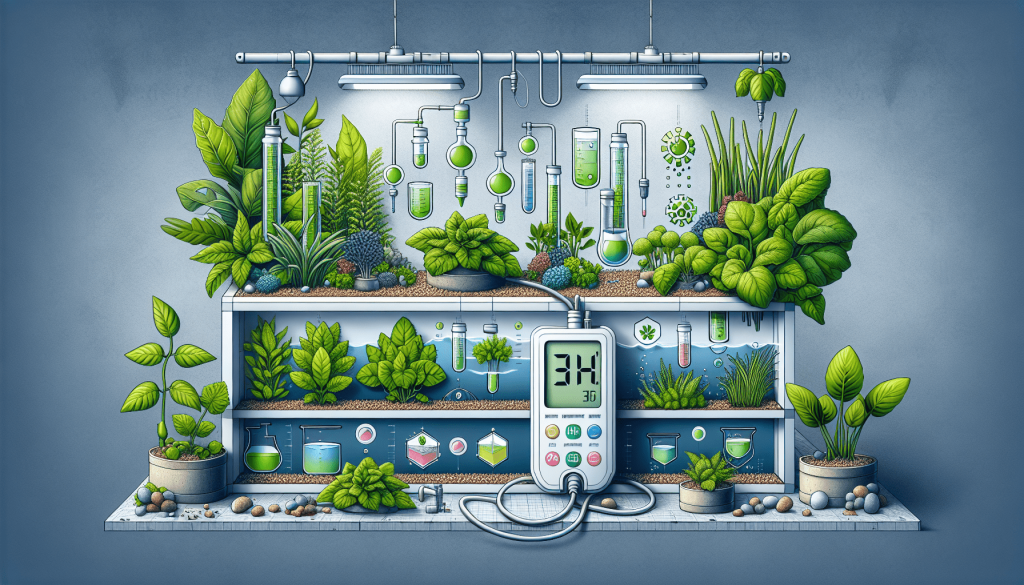
Maintaining pH in Different Hydroponic Systems
Different hydroponic systems may require specific considerations to maintain optimal pH levels and promote plant growth.
Drip Systems
In drip systems, where nutrient solution is periodically dripped onto the growing medium, pH stability is crucial. Monitoring and adjusting pH levels in the nutrient solution, as well as ensuring even distribution throughout the growing medium, are important for maintaining a healthy pH environment.
Ebb and Flow Systems
In ebb and flow systems, the nutrient solution periodically floods the plant roots and then drains away. Ensuring pH stability in the nutrient solution is important to prevent pH fluctuations. Regular monitoring and adjustment of pH levels, along with proper nutrient mixing and even flooding, help maintain pH balance in ebb and flow systems.
Aeroponic Systems
Aeroponic systems, which mist nutrient solution onto the plant roots suspended in the air, require careful pH management. Maintaining a stable and balanced pH level in the nutrient solution is important to prevent nutrient deficiencies or toxicities. Regular pH monitoring and adjustment, as well as ensuring proper nutrient atomization, are essential in aeroponic pH management.
Best Practices in pH Management
To maintain optimal pH levels in hydroponic systems, it is important to follow best practices in pH management.
Regular pH Monitoring
Regular monitoring of pH levels is crucial to catch any pH imbalances early on. Establishing a regular testing schedule and keeping accurate records of pH measurements and observations help maintain pH stability and identify any patterns or trends over time.
Proper Nutrient Solution Mixing
Properly mixing the nutrient solution is key to maintaining pH balance. Following recommended mixing ratios, accurately measuring and dosing nutrients, and ensuring thorough mixing before introducing the solution to the hydroponic system help prevent pH fluctuations and imbalances.
Plant-Specific pH Requirements
Different plants may have varying pH requirements for optimal growth. It is important to research and understand the specific pH preferences of the plants being grown and adjust the pH accordingly. By catering to the individual pH requirements of each plant, hydroponic gardeners can ensure maximum nutrient uptake and overall plant health.
In conclusion, maintaining pH levels is a critical aspect of successful hydroponic gardening. By understanding the importance of pH balance, measuring pH levels accurately, adjusting pH as needed, monitoring pH stability, preventing fluctuations, addressing common pH issues, and implementing appropriate pH management techniques, hydroponic gardeners can create an optimal growing environment for their plants. Following best practices in pH management ensures healthy growth, robust yields, and overall success in hydroponic gardening. Happy growing!
